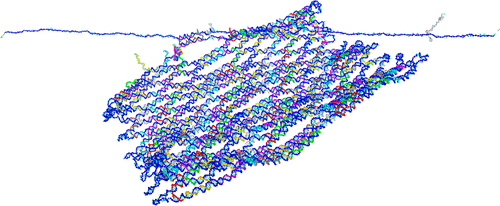Our official English website, www.x-mol.net, welcomes your
feedback! (Note: you will need to create a separate account there.)
Force-Induced Unravelling of DNA Origami
ACS Nano ( IF 15.8 ) Pub Date : 2018-05-31 00:00:00 , DOI: 10.1021/acsnano.8b01844 Megan C. Engel 1 , David M. Smith 2 , Markus A. Jobst 3 , Martin Sajfutdinow 2 , Tim Liedl 3 , Flavio Romano 4 , Lorenzo Rovigatti 1, 5, 6 , Ard A. Louis 1 , Jonathan P. K. Doye 7
ACS Nano ( IF 15.8 ) Pub Date : 2018-05-31 00:00:00 , DOI: 10.1021/acsnano.8b01844 Megan C. Engel 1 , David M. Smith 2 , Markus A. Jobst 3 , Martin Sajfutdinow 2 , Tim Liedl 3 , Flavio Romano 4 , Lorenzo Rovigatti 1, 5, 6 , Ard A. Louis 1 , Jonathan P. K. Doye 7
Affiliation

|
The mechanical properties of DNA nanostructures are of widespread interest as applications that exploit their stability under constant or intermittent external forces become increasingly common. We explore the force response of DNA origami in comprehensive detail by combining AFM single molecule force spectroscopy experiments with simulations using oxDNA, a coarse-grained model of DNA at the nucleotide level, to study the unravelling of an iconic origami system: the Rothemund tile. We contrast the force-induced melting of the tile with simulations of an origami 10-helix bundle. Finally, we simulate a recently proposed origami biosensor, whose function takes advantage of origami behavior under tension. We observe characteristic stick–slip unfolding dynamics in our force–extension curves for both the Rothemund tile and the helix bundle and reasonable agreement with experimentally observed rupture forces for these systems. Our results highlight the effect of design on force response: we observe regular, modular unfolding for the Rothemund tile that contrasts with strain-softening of the 10-helix bundle which leads to catastropic failure under monotonically increasing force. Further, unravelling occurs straightforwardly from the scaffold ends inward for the Rothemund tile, while the helix bundle unfolds more nonlinearly. The detailed visualization of the yielding events provided by simulation allows preferred pathways through the complex unfolding free-energy landscape to be mapped, as a key factor in determining relative barrier heights is the extensional release per base pair broken. We shed light on two important questions: how stable DNA nanostructures are under external forces and what design principles can be applied to enhance stability.
中文翻译:

力诱导的DNA折纸解体
随着在恒定或间歇性外力下利用其稳定性的应用变得越来越普遍,DNA纳米结构的机械性能受到广泛关注。我们通过将AFM单分子力谱实验与使用oxDNA的模拟相结合来全面详细地探索DNA折纸的力响应,oxDNA是一种在核苷酸水平上的DNA粗粒模型,用于研究标志性折纸系统的解散:Rothemund磁贴。我们对比了力诱导的瓷砖熔化与折纸10螺旋束的模拟。最后,我们模拟了最近提出的折纸生物传感器,其功能利用了在张力下的折纸行为。我们在Rothemund瓦和螺旋束的力-延伸曲线中观察到了典型的粘滑展开动态,并且与这些系统的实验观察到的破裂力合理地吻合。我们的结果突出了设计对力响应的影响:我们观察到Rothemund瓷砖的规则,模块化展开,这与10螺旋束的应变软化形成对比,后者在单调增加的力下导致催化失效。此外,从Rothemund瓷砖的脚手架端部向内直接进行拆开,而螺旋束的展开则更为非线性。通过模拟提供的屈服事件的详细可视化,可以绘制通过复杂的展开自由能态势的首选路径,确定相对势垒高度的关键因素是每个碱基对断裂的延伸释放。我们阐明了两个重要的问题:DNA纳米结构在外力作用下如何稳定以及可以应用哪些设计原理来增强稳定性。
更新日期:2018-05-31
中文翻译:

力诱导的DNA折纸解体
随着在恒定或间歇性外力下利用其稳定性的应用变得越来越普遍,DNA纳米结构的机械性能受到广泛关注。我们通过将AFM单分子力谱实验与使用oxDNA的模拟相结合来全面详细地探索DNA折纸的力响应,oxDNA是一种在核苷酸水平上的DNA粗粒模型,用于研究标志性折纸系统的解散:Rothemund磁贴。我们对比了力诱导的瓷砖熔化与折纸10螺旋束的模拟。最后,我们模拟了最近提出的折纸生物传感器,其功能利用了在张力下的折纸行为。我们在Rothemund瓦和螺旋束的力-延伸曲线中观察到了典型的粘滑展开动态,并且与这些系统的实验观察到的破裂力合理地吻合。我们的结果突出了设计对力响应的影响:我们观察到Rothemund瓷砖的规则,模块化展开,这与10螺旋束的应变软化形成对比,后者在单调增加的力下导致催化失效。此外,从Rothemund瓷砖的脚手架端部向内直接进行拆开,而螺旋束的展开则更为非线性。通过模拟提供的屈服事件的详细可视化,可以绘制通过复杂的展开自由能态势的首选路径,确定相对势垒高度的关键因素是每个碱基对断裂的延伸释放。我们阐明了两个重要的问题:DNA纳米结构在外力作用下如何稳定以及可以应用哪些设计原理来增强稳定性。











































 京公网安备 11010802027423号
京公网安备 11010802027423号